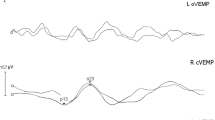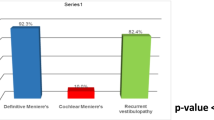Abstract
Purpose
To examine the concordance between cervical vestibular-evoked myogenic potential (cVEMP) tuning property test results and MRI findings of endolymphatic hydrops (EH).
Methods
Fourteen subjects (age 24–76 years) that had been diagnosed with unilateral definite Meniere’s disease (MD) (N = 8) or unilateral probable MD (N = 6) were enrolled. All of the subjects underwent cVEMP tests (using 500 Hz and 1000 Hz tone bursts), pure-tone audiometry, and gadolinium-enhanced 3 T-MRI. To examine tuning properties of cVEMP, the 500–1000 Hz amplitude ratio was calculated as the SLOPE. The results of the cVEMP tuning property test results were compared with EH-related MRI findings.
Results
EH positivity in both the cochlea and vestibule on MRI was observed in 7 of the 8 affected ears of definite MD and 3 of the 6 affected ears of probable MD, although it was only in one of the 14 unaffected ears. EH(+) or no response (NR) in cVEMP tuning property test was significantly associated with EH positivity on MRI, while EH(-) in the cVEMP tuning property test was significantly associated with EH-negativity on MRI (p = 0.0016 Fisher’s exact test test).
Conclusion
EH(+) or NR in the cVEMP tuning property test correspond well to EH positivity in the MRI findings. The cVEMP tuning property test is useful for screening and following up EH.


Similar content being viewed by others
References
Lopez-Escamez JA, Carey J, Chung WH et al (2015) Diagnostic criteria for Meniere’s disease. J Vestib Res 25:1–7
Nakashima T, Pyykko I, Arrol MA et al (2016) Meniere’s disease. Nat Rev Dis Primers 2:16028. https://doi.org/10.1038/nrdp.2016.28
Okuno T, Sando I (1987) Localization, frequency, and severity of endolymphatic hydrops and the pathology of the labyrinthine membrane in Menière’s disease. Ann Otol Rhinol Laryngol 96:438–445
Lin MY, Timmer FCA, Oriel BS et al (2006) Vestibular evoked myogenic potentials (VEMP) can detect asymptomatic saccular hydrops. Laryngoscope 116:987–992
Murofushi T, Komiyama S, Suizu R (2016) Detection of saccular endolymphatic hydrops in Ménière’s disease using a modified glycerol cVEMP test in combination with the tuning property test. Otol Neurotol 37:1131–1136
Aso S, Kimura H, Takeda S et al (1993) The intravenously administered glycerol test. Acta Otolaryngol Suppl 504:51–54
Gibson WP, Prasher DK, Kilkenny GP (1983) Diagnostic significance of transtympanic electrocochleography in Menière’s disease. Ann Otol Rhinol Laryngol 92:155–159
Futaki T, Kitahara M, Morimoto M (1977) A comparison of the furosemide and glycerol tests for Meniere’s disease. With special reference to the bilateral lesion. Acta Otolaryngol 183:272–278
Naganawa S, Yamazaki M, Kawai H et al (2012) Visualization of endolymphatic hydrops in Ménière’s disease after single-dose intravenous gadolinium-based contrast medium: timing of optimal enhancement. Magn Reson Med Sci 1:43–51
Nakashima T, Naganawa S, Pyykko I et al (2009) Grading of endolymphatic hydrops using magnetic resonance imaging. Acta Otolaryngol 129:5–8
Gürkov R, Kantner C, Strupp M et al (2014) Endolymphatic hydrops in patients with vestibular migraine and auditory symptoms. Eur Arch Otorhinolaryngol 271:2661–2667
Kahn L, Hautefort C, Guichard JP et al (2020) Relationships between video head impulse test, ocular and cervical vestibular evoked myogenic potentials, and compartmental magnetic resonance imaging classification in Meniere’s disease. Laryngoscope 130:E444–E452
Murofushi T, Ozeki H, Inoue A et al (2009) Does migraine-associated vertigo share a common pathophysiology with Meniere’s disease? Study with vestibular evoked myogenic potential. Cephalalgia 29:1259–1266
Murofushi T, Tsubota M, Suizu R et al (2017) Is alteration of tuning property in cVEMP specific for Meniere’s disease? Front Neurol 8:193. https://doi.org/10.3389/fneur.2017.00193
Murofushi T, Tsubota M, Suizu R et al (2017) cVEMP tuning property of patients with recurrent peripheral vestibulopathy: is it Meniere’s disease without hearing loss? Clinical Neurophysiol 128:2491–2492
Rauch SD, Zhou G, Kujawa SG et al (2004) Vestibular evoked myogenic potentials show altered tuning in patients with Meniere’s disease. Otol Neurotol 25:333–338
Murofushi T, Tsubota M, Kitao K et al (2018) Simultaneous presentation of definite vestibular migraine and definite Ménière’s disease: overlapping syndrome of two diseases. Front Neurol 9:749. https://doi.org/10.3389/fneur.2018.00749
Murofushi T (2016) Clinical application of vestibular evoked myogenic potential (VEMP). Auris Nasus Larynx 43:367–376
Murofushi T, Nakahara H, Yoshimura E et al (2011) Association of air-conducted sound oVEMP findings with cVEMP and caloric test findings in patients with unilateral peripheral vestibular disorders. Acta Otolaryngol 131:945–950
Guo P, Sun W, Shi S et al (2019) Quantitative evaluation of endolymphatic hydrops with MRI through intravenous gadolinium administration and VEMP in unilateral-definite Meniere’s disease. Eur Arch Otorhinolaryngol 276:993–1000
Okumura T, Imai T, Takimoto Y et al (2017) Assessment of endolymphatic hydrops and otolith function in patients with Meniere’s disease. Eur Arch Otorhinolaryngol 274:1413–1421
Katayama N, Yamamoto M, Teranishi M et al (2010) Relationship between endolymphatic hydrops and vestibular-evoked myogenic potential. Acta Otolaryngol 130:917–923
Murofushi T, Halmagyi GM, Yavor RA et al (1996) Absent vestibular evoked myogenic potentials in vestibular neurolabyrinthitis; an indicator of involvement of the inferior vestibular nerve? Arch Otolaryngol Head Neck Surg 122:845–848
Kang WS, Lee SH, Yang CJ et al (2016) Vestibular function tests for vestibular migraine: clinical implication of video head impulse and caloric tests. Front Neurol 7:166. https://doi.org/10.3389/fneur.2016.00166
Murofushi T, Matsuzaki M, Mizuno M (1998) Vestibular evoked myogenic potentials in patients with acoustic neuromas. Arch Otolaryngol Head Neck Surg 24:509–512
Rosengren SM, Kingma H (2013) New perspective on vestibular evoked myogenic potentials. Curr Opin Neurol 26:74–80
Maxwell R, Jerin C, Gürkov R (2017) Utilisation of multi-frequency VEMPs improves diagnostic accuracy for Meniere’s disease. Eur Arch Otorhinolaryngol 274:85–93
Shiraishi K, Ohira N, Kobayashi T et al (2020) Comparison of furosemide-loading cervical vestibular-evoked myogenic potentials with magnetic resonance imaging for the evaluation of endolymphatic hydrops. Acta Otolaryngol 140:723–727
Quatre R, Attye A, Karkas A et al (2019) Relationship between audio-vestibular functional tests and inner ear MRI in Mneiere’s disease. Ear Hear 40:168–176
Obeidat FS, Lewis BS (2019) Comparing the sensitivity and specificity of cervical vestibular-evoked myogenic potentials and electrocochleography in the diagnosis of Meniere’s disease. Int J Audiol 58:738–746
Hornibrook J, Flook E, Greig S et al (2015) MRI inner ear imaging and tone burst electrocochleography in the diagnosis of Meniere’s disease. Otol Neurotol 36:1109–1114
Funding
This study was partially supported by Grants-in-Aid for Scientific Research (C) from the Japan Society for the Promotion of Science (15K10764, 19K09856) and a grant from AMED (grant number: JP19dk0310092).
Author information
Authors and Affiliations
Corresponding author
Ethics declarations
Conflict of interest
The authors declare that they have no conflict of interest.
Ethics statement
Informed consent was obtained from each subject. This study was approved by the ethics committee of Teikyo University.
Availability of data statement
All datasets generated for this study are available.
Additional information
Publisher's Note
Springer Nature remains neutral with regard to jurisdictional claims in published maps and institutional affiliations.
Rights and permissions
About this article
Cite this article
Murofushi, T., Tsubota, M., Kanai, Y. et al. Association of cervical vestibular-evoked myogenic potential tuning property test results with MRI findings of endolymphatic hydrops in Meniere’s disease. Eur Arch Otorhinolaryngol 278, 3267–3273 (2021). https://doi.org/10.1007/s00405-020-06410-z
Received:
Accepted:
Published:
Issue Date:
DOI: https://doi.org/10.1007/s00405-020-06410-z




